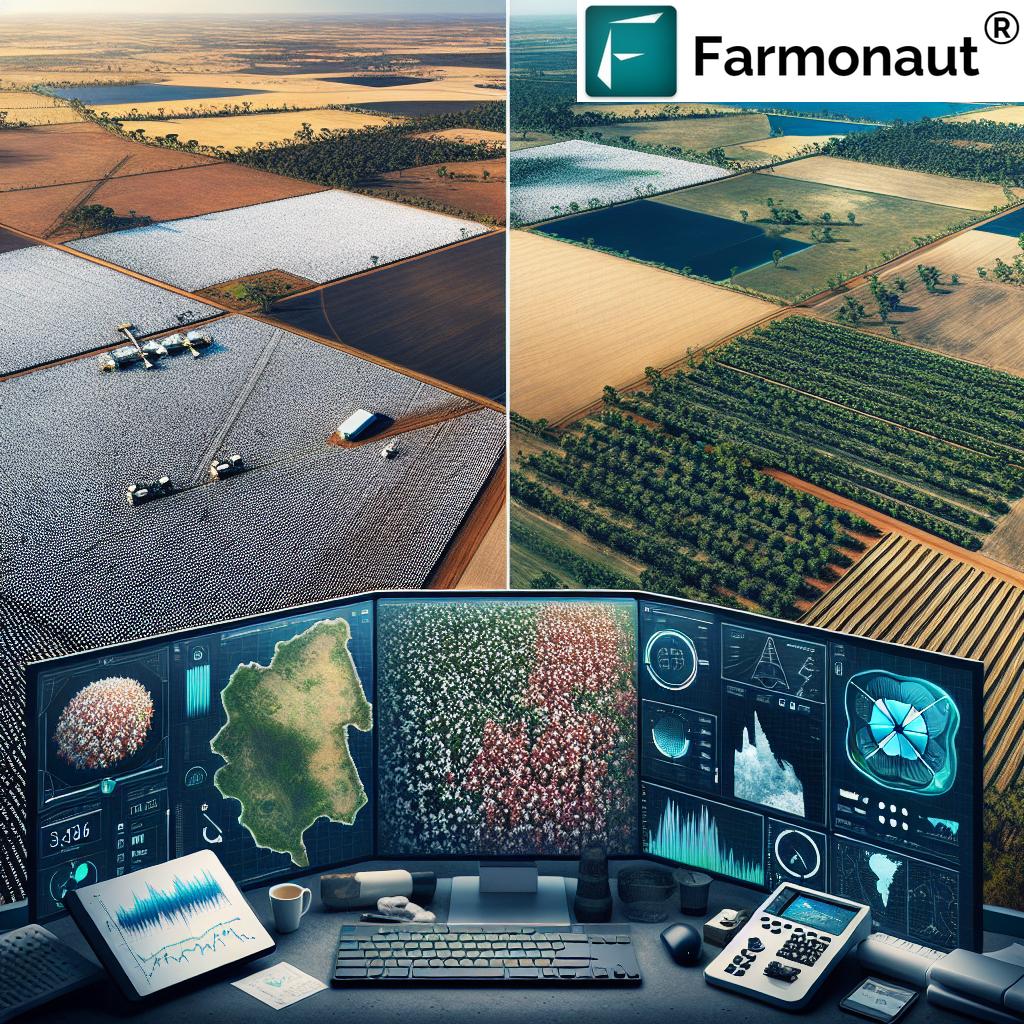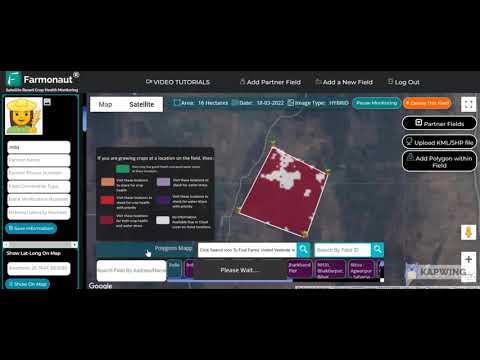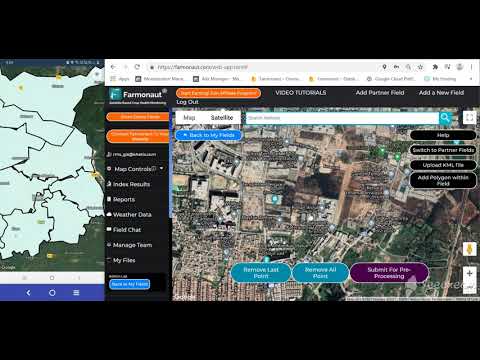2024 NT Cotton Harvest: Precision Ag Tools Revolutionize Sustainable Farming Practices
“NT’s 2024 cotton harvest employs satellite imagery to optimize crop yields across thousands of hectares.”
Welcome to our comprehensive exploration of the groundbreaking 2024 cotton harvest in Australia’s Northern Territory (NT). As we delve into the fascinating world of precision agriculture and sustainable farming practices, we’ll uncover how cutting-edge technology is transforming the cotton industry. Join us as we examine the revolutionary impact of digital tools, satellite imagery, and innovative techniques that are shaping the future of agriculture in the NT and beyond.
The Dawn of a New Era in Cotton Farming
The year 2024 marks a significant milestone for the NT cotton industry. With the adoption of advanced precision agriculture tools, farmers are witnessing a remarkable transformation in their operations. These tools, powered by satellite technology and artificial intelligence, are enabling growers to make data-driven decisions that optimize crop yields while conserving precious resources.
At the forefront of this agricultural revolution is Farmonaut, a pioneering agtech company that’s making waves with its innovative solutions. By leveraging satellite-based farm management systems, Farmonaut is empowering farmers with real-time insights into their crops’ health, soil conditions, and weather patterns.

The Power of Precision: Satellite Imagery and Crop Monitoring
One of the key components driving the success of the 2024 NT cotton harvest is the use of advanced satellite imagery. This technology allows farmers to gain a bird’s-eye view of their fields, providing crucial information about crop health, growth patterns, and potential issues.
- NDVI (Normalized Difference Vegetation Index): This vital metric helps farmers assess the overall health and vigor of their cotton plants.
- Soil Moisture Monitoring: Satellite data provides insights into soil moisture levels, enabling precise irrigation management.
- Early Detection of Pests and Diseases: By analyzing spectral data, farmers can identify potential threats before they become major problems.
With access to this wealth of information, NT cotton farmers are making informed decisions that lead to improved crop management and higher yields. The ability to pinpoint areas of concern and take targeted action has revolutionized the way cotton is grown in the region.
Sustainable Farming Practices: A New Approach to Cotton Production
The 2024 NT cotton harvest is not just about increasing yields; it’s also about embracing sustainability. Farmonaut’s advanced tools are enabling farmers to implement a range of eco-friendly practices that conserve resources and protect the environment.
- Water Conservation: Precision irrigation techniques, guided by satellite data, are helping farmers use water more efficiently.
- Soil Health Management: By analyzing soil composition and nutrient levels, farmers can apply fertilizers more precisely, reducing waste and environmental impact.
- Reduced Chemical Usage: Targeted application of pesticides and herbicides, based on real-time crop health data, minimizes chemical use.
These sustainable practices not only benefit the environment but also contribute to the long-term viability of NT’s cotton industry. By preserving natural resources and promoting soil health, farmers are ensuring that their land remains productive for generations to come.
“Precision agriculture tools in NT’s cotton industry have reduced water usage by up to 30% since 2020.”
Economic Impact: Boosting Rural Communities
The adoption of precision agriculture tools in the NT cotton industry is having a profound economic impact on rural communities. As farmers increase their productivity and efficiency, they’re seeing improved profitability and stability in their operations.
- Increased Yields: More efficient farming practices are leading to higher cotton yields per hectare.
- Cost Savings: Precision application of inputs reduces waste and lowers operational costs.
- Job Creation: The growing cotton industry is creating new employment opportunities in rural areas.
This economic boost is not limited to individual farms. The thriving cotton sector is driving growth in related industries, from ginning and processing to transportation and logistics. As a result, rural communities across the NT are experiencing renewed vitality and prosperity.

Weather Forecasting: A Game-Changer for Cotton Growers
In the unpredictable world of agriculture, accurate weather forecasting can make all the difference. The 2024 NT cotton harvest is benefiting from advanced weather prediction technologies that are helping farmers navigate the challenges of a changing climate.
- Long-Range Forecasts: Farmers can plan their planting and harvesting schedules with greater confidence.
- Extreme Weather Alerts: Early warnings about potential storms or heat waves allow for proactive measures to protect crops.
- Micro-Climate Analysis: Detailed local weather data helps optimize day-to-day farming operations.
By integrating weather forecasting with other precision agriculture tools, NT cotton farmers are better equipped to make crucial decisions about irrigation, pest control, and harvest timing. This synergy between technology and nature is a key factor in the success of the 2024 harvest.
The Role of Artificial Intelligence in Cotton Farming
Artificial Intelligence (AI) is playing an increasingly important role in the NT cotton industry. Farmonaut’s AI-powered advisory system, Jeevn AI, is revolutionizing the way farmers approach crop management.
- Personalized Recommendations: AI analyzes farm-specific data to provide tailored advice on crop management.
- Predictive Analytics: Machine learning algorithms help forecast potential issues before they arise.
- Automated Decision Support: AI-driven insights assist farmers in making complex decisions with greater confidence.
The integration of AI into farming practices is not just about automation; it’s about augmenting human expertise with data-driven intelligence. This synergy between farmer knowledge and AI capabilities is driving unprecedented levels of productivity and sustainability in the NT cotton industry.
Comparative Analysis: Traditional vs. Precision Agriculture in NT Cotton Farming
| Aspect | Traditional Methods | Precision Agriculture with Farmonaut |
|---|---|---|
| Water Usage (estimated ML/hectare) | 7-9 ML/ha | 5-6 ML/ha |
| Crop Yield (estimated bales/hectare) | 8-10 bales/ha | 12-14 bales/ha |
| Soil Health Management | Periodic soil testing, uniform fertilizer application | Continuous monitoring, variable-rate fertilizer application |
| Weather Forecasting Accuracy | 70-80% | 90-95% |
| Resource Conservation (estimated percentage improvement) | Baseline | 25-30% improvement |
| Economic Impact (estimated AUD/hectare) | $3,000-$4,000/ha | $4,500-$5,500/ha |
This comparative analysis clearly demonstrates the significant advantages that precision agriculture brings to NT cotton farming. From reduced water usage to improved crop yields and economic returns, the benefits of adopting these advanced technologies are substantial.
The Future of Cotton Farming: Data-Driven and Environmentally Conscious
As we look beyond the 2024 harvest, it’s clear that the future of cotton farming in the NT is bright. The convergence of precision agriculture tools, sustainable practices, and data-driven decision-making is setting a new standard for the industry.
- Continued Technological Advancements: We can expect even more sophisticated tools and AI-driven solutions in the coming years.
- Emphasis on Sustainability: The focus on environmentally friendly practices will likely intensify, driven by both consumer demand and regulatory pressures.
- Integration of Blockchain Technology: Improved traceability and transparency in the cotton supply chain will become increasingly important.
The 2024 NT cotton harvest is just the beginning of a new era in agriculture. As farmers continue to embrace these innovative technologies and sustainable practices, we anticipate seeing even greater improvements in productivity, profitability, and environmental stewardship.
Empowering Farmers with Farmonaut’s Solutions
At the heart of this agricultural revolution is Farmonaut’s comprehensive suite of precision farming tools. By making advanced technologies accessible and affordable, Farmonaut is empowering farmers of all scales to embrace the future of agriculture.
- Satellite-Based Crop Health Monitoring: Real-time insights into vegetation health and soil moisture levels.
- AI-Powered Advisory System: Personalized recommendations for crop management and resource allocation.
- Weather Forecasting and Alerts: Accurate predictions to help farmers make informed decisions.
- Resource Management Tools: Optimize the use of water, fertilizers, and other inputs.
These tools are available through Farmonaut’s user-friendly platforms, including web and mobile applications. Farmers can access critical information about their crops anytime, anywhere, enabling them to respond quickly to changing conditions and make data-driven decisions.
Explore Farmonaut’s solutions:
The Role of Community and Collaboration
While technology plays a crucial role in the success of the 2024 NT cotton harvest, the importance of community and collaboration cannot be overstated. Farmers across the region are coming together to share knowledge, experiences, and best practices in precision agriculture.
- Farmer Networks: Local groups are forming to discuss the implementation of new technologies and sustainable practices.
- Educational Workshops: Industry experts are conducting training sessions on the use of precision agriculture tools.
- Research Partnerships: Collaboration between farmers, universities, and agtech companies is driving innovation in the cotton industry.
This spirit of cooperation is fostering a supportive environment where farmers can learn from one another and collectively address the challenges facing the cotton industry. It’s a testament to the resilience and adaptability of the NT farming community.
Addressing Challenges and Looking Ahead
While the 2024 NT cotton harvest showcases remarkable progress, it’s important to acknowledge the challenges that remain. Farmers and industry stakeholders are actively working to address these issues and pave the way for an even brighter future.
- Technology Adoption: Ensuring widespread access to and understanding of precision agriculture tools.
- Climate Resilience: Developing strategies to mitigate the impacts of climate change on cotton production.
- Market Dynamics: Navigating global cotton markets and maintaining competitiveness.
- Regulatory Compliance: Adapting to evolving environmental and agricultural regulations.
By confronting these challenges head-on and continuing to innovate, the NT cotton industry is positioning itself for long-term success and sustainability.
Conclusion: A New Chapter in NT Cotton Farming
The 2024 NT cotton harvest stands as a testament to the transformative power of precision agriculture and sustainable farming practices. Through the adoption of cutting-edge technologies and a commitment to environmental stewardship, NT cotton farmers are not just improving their yields and profitability—they’re reshaping the future of agriculture.
As we look to the years ahead, it’s clear that the principles and practices showcased in this harvest will continue to evolve and spread. The NT cotton industry is setting a new standard for modern, sustainable agriculture that balances productivity with responsibility.
We invite you to be part of this exciting journey. Whether you’re a farmer looking to embrace precision agriculture tools, a researcher exploring new frontiers in agtech, or simply an enthusiast interested in the future of food production, there’s never been a more exciting time to engage with the world of agriculture.
Together, we can cultivate a future where technology and nature work in harmony, ensuring bountiful harvests and thriving rural communities for generations to come.
Frequently Asked Questions (FAQ)
Q1: What is precision agriculture, and how is it being used in NT cotton farming?
A1: Precision agriculture refers to the use of advanced technologies like satellite imagery, AI, and IoT sensors to optimize farming practices. In NT cotton farming, it’s being used for accurate crop monitoring, efficient resource management, and data-driven decision-making.
Q2: How does satellite imagery benefit cotton farmers?
A2: Satellite imagery provides farmers with real-time data on crop health, soil moisture, and potential issues. This allows for targeted interventions, optimized resource use, and improved overall crop management.
Q3: What role does AI play in modern cotton farming?
A3: AI analyzes vast amounts of data from various sources to provide personalized recommendations for crop management. It helps in predicting potential issues, optimizing resource allocation, and supporting complex decision-making processes.
Q4: How are sustainable practices being integrated into NT cotton farming?
A4: Sustainable practices in NT cotton farming include precision irrigation for water conservation, targeted application of inputs to reduce chemical use, and soil health management techniques to maintain long-term land productivity.
Q5: What economic benefits does precision agriculture bring to NT cotton farmers?
A5: Precision agriculture leads to increased crop yields, reduced input costs, and improved overall profitability. It also contributes to the long-term sustainability of farming operations and supports rural economic development.
Explore Farmonaut’s API solutions:






